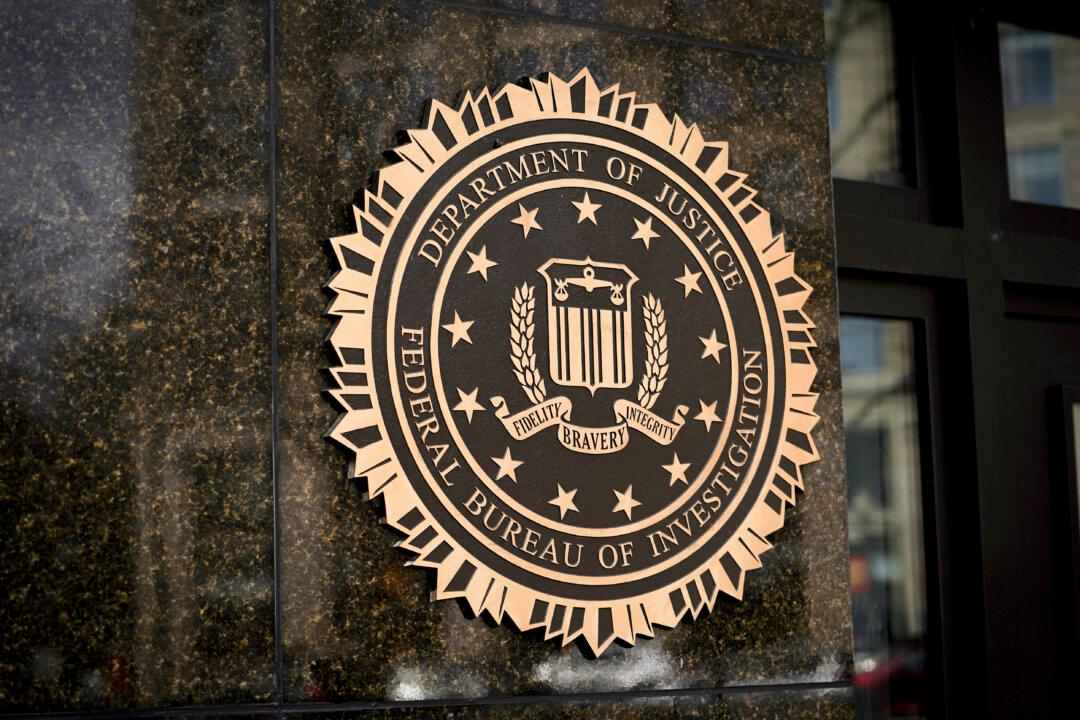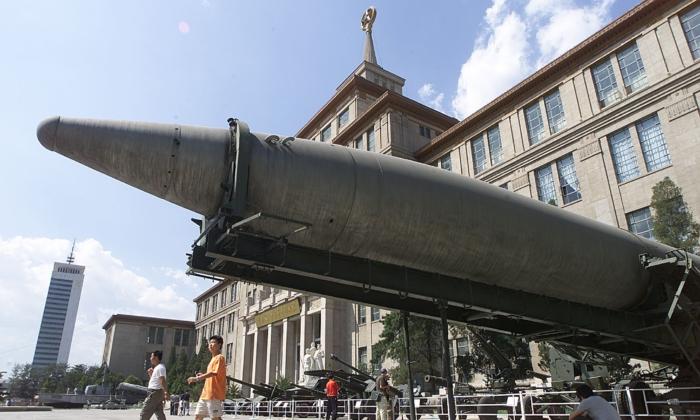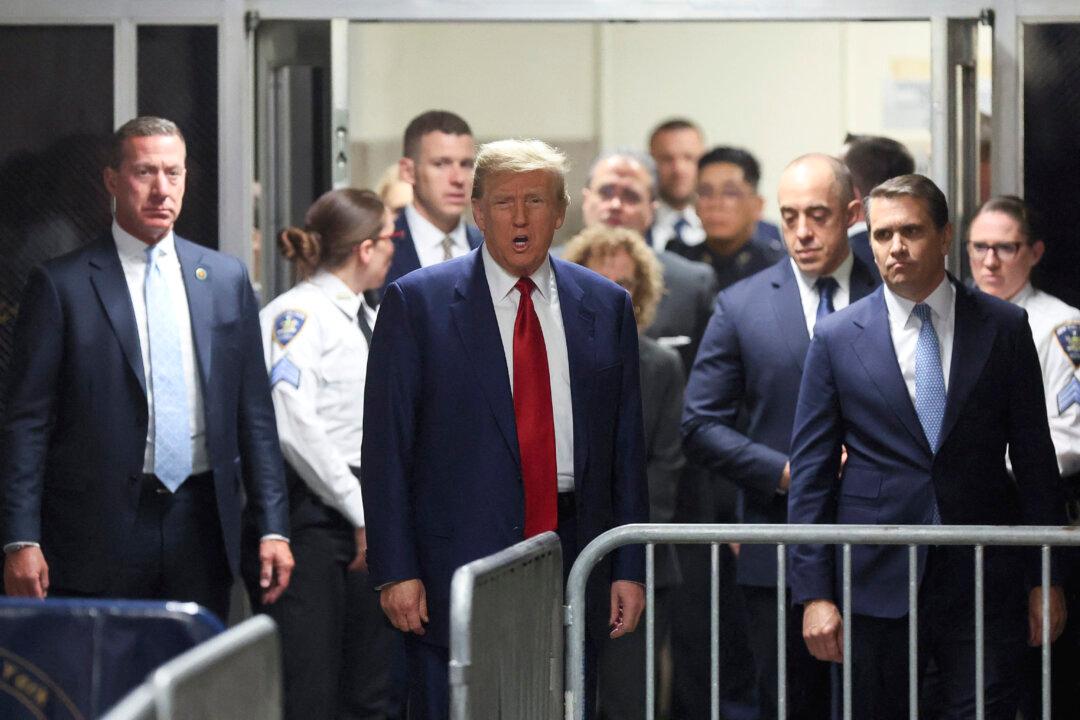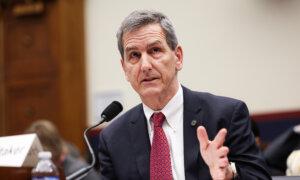
Friday, March 29, 2024
Thursday, March 28, 2024
New Bomb Threat, Mass Shooting Threat Made Against US Arts Group Shen Yun

A bomb threat and a threat of a mass shooting have been sent to the headquarters of Shen Yun Performing Arts, an art group founded by Chinese dissidents that has long faced harassment by the Chinese Communist Party (CCP).
The messages were received just days after similar bomb threats were sent to two theaters where Shen Yun was performing over the weekend in California and Canada, prompting evacuations and bomb sweeps by police. No explosives were found.
The company received a series of emails on March 26 that claimed explosives were placed at its headquarters in upstate New York and that individuals will sneak onto the property, “shoot everyone on sight,” and “throw grenades,” the emails, obtained by The Epoch Times, read.
The Shen Yun headquarters is located at a site called Dragon Springs which also hosts two art schools and Tang Dynasty-style temples. The bomb threat asked for a ransom.
“Multiple C4 plastic bombs have been placed in various locations in the Dragon Springs Temple at the Shawangunk Ridge, upstate New York. If you don’t want to see the Dragon Springs Temple to be turned into ruins, then transfer US$58 million before 3 pm tomorrow to my PayPal account … If the money hasn’t arrived by 3 o’clock, we will detonate the bombs,” said the email, written in Mandarin.
The mass shooting threat, sent from a separate email address, didn’t ask for money.
“We will sneak into the Dragon Springs Temple in the Shawangunk Ridge, upstate New York, in the near future, shooting at whomever we see with guns and throwing grenades at crowds!,” the email, also in Mandarin, said.
Yet another email sent on the same day went into a chaotic, expletive-laced rant with the sender seemingly irked by the fact that Dragon Springs and Shen Yun reported the threats to the police and the media.
“Me, your Big Boss, has made headlines hundreds of times! The FBI isn’t worth worrying about at all,” it said, arguing that “Keeping sending [such emails] will wear the police out sooner or later, and they will just think it’s the boy who cried wolf.”
“Then one day [I] will really place bomb[s] in the theater. If it kills one of you, there will be one less traitor,” it said.
The first bomb threat targeting Dragon Springs was sent on March 14.
The messages, all obtained by The Epoch Times, were sent from different email addresses, though there were similarities between some of the addresses.
Armed Man
On Sept. 7, 2023, the FBI issued an officer safety alert stating that a man “has made threats to the Dragon Springs campus,” was seen in the area and was “potentially armed and dangerous.”The man, of Chinese descent, “claimed he wanted to be on a ‘suicide squad’,” the FBI alert read. It also noted the man had videos of “demonstrating loading his guns.”
As a result of the potential threat to the on-site schools, all entrances were guarded by law enforcement.
“At one point, this man was known to be in the area of our campus. ... We had state police patrolling our entrances, and everyone was on high alert,” George Xu, vice president of Dragon Springs, told The Epoch Times.

Police subsequently searched the man’s home and found a handgun, an AR-15 rifle, more than 600 rounds of ammunition, and 14 magazines for the weapons, about half of which were loaded, a police report obtained by The Epoch Times said.
Other Incidents
In a separate incident, Shen Yun tour buses were vandalized last week in Costa Mesa, California, in a manner that could have caused a serious accident.Tires on two buses were slashed halfway through the rubber, based on images provided by Shen Yun as well as a description of the damage in a Costa Mesa Police Department report obtained by The Epoch Times. This kind of damage doesn’t cause the tire to deflate but rather to burst while driving at speed.
Due to previous similar incidents in the United States and Canada, in which Shen Yun bus tires were cut in the same way, the company has been forced to employ security personnel to watch its buses day and night. In Costa Mesa, however, the buses were taken to a local garage for maintenance, and the cuts were noticed after they were picked up.

The police are investigating the incident.
CCP Campaign
Shen Yun has been a major cultural force, growing to eight touring ensembles that perform for about a million people every year. Its portrayal of authentic Chinese culture, under the tagline of “China before communism,” is perceived by the CCP as a threat to its dominance in the cultural field.“They [the CCP] want to say Chinese culture is socialist,” according to Trevor Loudon, an expert on communist regimes and their overseas influence operations.
Some Shen Yun artists say their relatives in China have been questioned by police, or even imprisoned, in an effort to intimidate them.

“First, they threatened governments to not allow Shen Yun. When that didn’t really work, they started threatening theaters. When that didn’t really work, they started slashing our bus tires,” said Ying Chen, a vice president of Shen Yun Performing Arts.
“When that didn’t stop us, they started smear campaigns online and sent crazy emails to theater managers. Now, they have stooped even lower, sending ‘bomb threat’ emails.”
Many of the artists practice Falun Gong, an ancient Chinese spiritual discipline that includes slow-moving exercises and tenets of truthfulness, compassion, and forbearance.
In 1999, then-leader of the CCP, Jiang Zemin, launched a campaign to “eradicate” Falun Gong after the regime estimated the practice had 70-100 million followers, outpacing CCP membership.
Human rights groups have documented mass arrests, detention, torture, and murder of Falun Gong followers in China. An independent China Tribunal in the UK concluded in 2019 that the CCP also used Falun Gong detainees as a source of organs to fuel its massive transplant industry.
Some Shen Yun dance pieces artistically depict scenes from the persecution
Column: Funds stampede into copper as price breaks higher

https://www.mining.com/web/column-funds-stampede-into-copper-as-price-breaks-higher/
Fund managers have rushed to buy copper after the price broke up out of its one-year trading range earlier this month.
Activity has surged on all three global exchanges with money managers lifting bullish bets on both the London Metal Exchange (LME) and the CME copper contracts. Market open interest on the Shanghai Futures Exchange (ShFE) has jumped to life-of-contract highs.
Sign Up for the Copper Digest
Much of the investment community had stayed away from copper’s sideways churn over the last year but funds are now clearly re-entering on the long side after LME three-month metal leapt to an 11-month high of $9,164.50 per metric ton on March 18.
A fresh technical picture and signs of supply stress have served to rekindle copper’s bullish flames. However, they could yet be doused if the market can’t hold its recent gains.

Bull stampede
Money manager long positions on the CME copper contract jumped by 43% to 99,829 contracts in the week to March 18, according to the latest Commitments of Traders Report (COTR).
It’s the largest outright fund long position since May 2021. Net long positioning of 39,270 contracts is the most bullish it’s been since this time last year when the market was still pinning its hopes on a post-lockdown growth surge in China.
The bulls have been stampeding into the London market as well. Investment fund long positions soared to 70,293 contracts in the week to March 15. It’s the heaviest cumulative bet on higher prices since the LME started publishing its COTR in 2018.
There are still plenty of fund shorts around and net long positioning of 37,863 contracts is the highest in “only” two years.
Positioning in the LME’s “Other Financial” category, which includes commodity index providers and insurance companies, has also started turning more bullish. The net long position has grown to 11,693 contracts, also a near two-year high.
There is no comparable COTR in China but it’s clear that copper’s break of trading range has put it on the radar of the local investment community.
Market open interest on the Shanghai copper contract rocketed from 388,000 contracts at the start of the month to 566,000 on March 15. It has since retreated marginally to 533,000 contracts.

Key price level
The trigger for all the excitement in the previously torpid copper market was a commitment by Chinese smelters to restrain output in the face of a tighter-than-expected raw materials market.
What exactly this means for the supply-demand balance in the refined segment of the supply chain remains uncertain. There is a good deal of scepticism among analysts as to how many smelters will actually cut production rather than re-schedule maintenance shutdowns or defer new capacity.
It has, though, refocused attention on copper’s stretched supply dynamics, a feature of the market that has been overshadowed by a weak demand picture over the last year or so.
Clearly, plenty of fund managers are buying into the change of narrative but whether others will join them depends on whether copper can consolidate its chart gains.
The most recent COTRs capture the build in long positions just before copper peaked above $9,000 per ton. Much of the money entering the market was likely reacting to the chart break and the resulting upwards price momentum.
LME three-month copper has since retraced all the way to a current $8,860 per ton, a key technical level that acted as resistance in the previous year-long trading range and which, bulls hope, will now provide support for a new higher range.
If that resistance-turned-support thesis holds, heavier-weight money may well follow the shorter-term technical funds into the market. If, however, copper can’t hold its gains and falls back into the old range, some of its new fund friends may disappear as quickly as they came.
(The opinions expressed here are those of the author, Andy Home, a columnist for Reuters.)
(Editing by David Evans)
A global Carbon tax on shipping is coming, says ABS Chairman and CEO

https://www.tankeroperator.com/ViewNews.aspx?NewsID=14189
Global Regulatory Framework is essential for a global industry, says Christopher J. Wiernicki in CERAWeek Appearance
FDA Concedes on Ivermectin, Yet Deeper Concerns Exist

After years of controversy over using ivermectin to fight COVID-19, the U.S. Food and Drug Administration (FDA) finally gave in and agreed to remove its social media posts that urge people to stop using the drug.
Nature’s ‘Wonder Drug’ and Gift to Humans
Like many low-cost remedies, ivermectin is a gift from nature with a glorious history.Professor Satoshi Omura discovered ivermectin in Japanese soil in 1975. He isolated a bacteria—Streptomyces avermectinius from the soil and found a new compound, avermectin, the precursor to ivermectin. He then modified avermectin into a safer and more effective drug—ivermectin.
This drug has saved hundreds of millions of people around the world suffering from two parasitic diseases that have plagued tropical regions for centuries—river blindness and lymphatic filariasis. It has also been proven effective in treating many other parasitic infections, including gastrointestinal roundworms, mites, ticks, and scabies.
When a virus enters a human cell, it is carried by a vehicle-like transporter to replicate inside the cell and spread throughout the body. Ivermectin has the ability to block the function of this transporter, thereby preventing the virus from replicating and spreading.
Impressive Versatility
Modern drug development follows a one-disease, one-target principle, where drugs are designed to target specific pathogens.As a drug primarily extracted from nature, ivermectin has shown impressive versatility in its uses within the human body. Similar to other natural compounds, ivermectin has the ability to act on multiple targets simultaneously. These types of natural compounds can be thought of as a Swiss army knife, designed not for just one purpose, but with many potential uses waiting to be discovered.
Initially, ivermectin was found to have a specific target, paralyzing certain muscles in worms while having little effect on mammals.
Use in Treating COVID-19
When a new viral outbreak occurs, scientists typically test existing drugs for efficacy, as developing new drugs within a short timeframe is often impossible. An example of this is SARS-CoV-2.Scientists considered using ivermectin as a potential solution, and it proved to be effective, resulting in one success after another.
It has also demonstrated efficacy in specific human studies.
These observational studies have a strict level of control and exclude the bias from confounding factors in treated and non-treated groups, presenting an advantage over randomized controlled trials (RCT).
If a drug has treatment potential and is relatively safe, doctors should be allowed to use it off-label as long as they follow the correct human dosage.
Limitations and Cautions
While every drug has its benefits, they should always be taken responsibly due to potential side effects.More to Be Corrected
The labeled indications of an approved drug are often limited due to sluggish industry procedures or knowledge gaps. As a result, doctors in the United States are allowed to prescribe drugs off-label for a purpose other than the one for which the drug was approved.Despite strong clinical evidence for the use of ivermectin in COVID-19 treatment, the drug has been largely underutilized and has even been banned by authorities for non-scientific reasons.
As noted at the beginning of the article, the recent settlement of the ivermectin case is a significant step in reducing the FDA’s excessive involvement in the relationship between doctors and patients. Many lives could have been saved if ivermectin and other early treatments had been made available instead of being ignored, vilified, and underutilized.
What constitutes genuine science? And what is the appropriate path to advance science and medicine?
Humans may not fully appreciate the real benefits and values of nature, including its role in preventing epidemics.
Since the outbreak of COVID-19, a silent war started between those pursuing cutting-edge technology and those favoring more traditional approaches.
One side pursuing advanced technology has chosen to develop vaccines, even utilizing mRNA technology despite its immaturity. This has led to an unprecedented, bold and massive experimentation in hundreds of millions of humans.
The other approach involves looking inward, improving our diet and lifestyle, balancing our immunity, and utilizing natural remedies.
This is not to say we shouldn’t develop new drugs or vaccines; it’s undoubtedly positive if they are effective. However, we should not let human arrogance, money, or politics blind us and tarnish real science.
The ultimate goal of scientific research is to benefit people—not solely to pursue advanced medical treatments.
Advanced pharmaceuticals do not always equate to superior medications, just as everyone is aware that high-tech, synthetic foods are not optimal for our health.
When Hippocrates, the father of Western medicine, pioneered the systematic study of clinical medicine, he could not have envisioned this present-day scenario.
How far have we strayed? When will we abandon these harmful ideas and return to the right path?
Wednesday, March 27, 2024
Tuesday, March 26, 2024
Monday, March 25, 2024
CCP’s Military Growth ‘Largely Funded’ by US: Ret. Navy Capt.

The Chinese Communist Party has aggressively built up its military, expanding its arsenal of both conventional and nuclear capabilities. The growth was largely funded by its rival, the United States.
“The Chinese Navy now is over 150 naval combatants greater than the U.S. Navy. They are now the largest navy in terms of numbers of hulls and tonnage,” said Mr. Fanell, also a former Director of Intelligence and Information Operations for the U.S. Pacific Fleet. “Over the last decade, they’ve produced more tonnage and battle force missiles. The Chinese have more anti-ship cruise, longer-range, supersonic missiles.”
“In just that one area of the navy, they’ve gone from being an inferior, coastal, brown water navy … to being a global navy.”
The naval forces’ development, according to Mr. Thayer, is “largely funded” by the United States.
“We did that. Wall Street and our investors gave them the money to grow their economy and to build the weapons to kill us,” he said.
But it’s not just happening with the Chinese navy. “Every aspect of its military growth, economic growth, diplomatic growth, science, technology, lunar exploration, and space exploration that we are witnessing is due to the Americans,” said Mr. Thayer, a contributor to The Epoch Times. “Its peer enemy funded it and allowed it to grow.”
To prevent the regime from rising, “the first rule of strategy is don’t assist your enemy,” said Mr. Thayer, co-author of the new book, “Embracing Communist China: America’s Greatest Strategic Failure.”
‘Imminent’ Threat’
The Chinese Communist Party (CCP) leader Xi Jinping has said the country’s armed forces will be brought to a “world-class” standard, capable of “fighting and winning wars” by mid-century, fueling concerns about a potential war with Taiwan and the United States.The effects of a potential conflict would not be limited to Taiwan and its 23 million people, according to Mr. Fanell. The U.S. sailors, soldiers, marines, and airmen stationed over there would suffer too.
“They will be in the frag pattern if China decides to invade Taiwan,” he said, describing the threat from China as “imminent,” “real,” and “credible.”
If China takes over Taiwan, its chip factories could end up being controlled by the communist regime.
For people living on U.S. soil, “what does that mean to them when Taiwan falls and now all of a sudden computer chips and all that technology is in the hands of the Chinese Communist Party?” Mr. Fanell asked.
Were communist China to seize its democratic neighbor, another thing could happen to the U.S. economy: the CCP could interfere with the $5 trillion worth of global goods transiting through the South China Sea, he suggested.
“The Chinese will say, ‘We control who can come through because we’re the masters of the universe. If you’re not obeying us, your stuff cannot come through.”
According to an estimate by CMI, a Noraway-based think tank, direct Norwegian fish exports to China were reduced by at least $125 million from 2010 to 2013.
“It doesn’t matter who it is or where it is. They will use economic warfare like a Navy ship would use a gun. They use it that way,” Mr. Fanell said.

Nuclear Munitions
Mr. Fanell said America was the world’s top shipbuilder in the 1940s. In the past 80 years, however, U.S. shipbuilding accounted for less than 1 percent of the global share, according to United Nations data. In comparison, China produced 46 percent of the world’s commercial vessels in 2022, taking the number-one slot in terms of shipbuilding.“We are in a mismatch in the ability to ramp up our military capabilities with the production of weaponry that we haven’t seen since before World War II.”
The preparation takes time, but the threat from China is imminent. Mr. Fanell suggested America start talking with allies in the Indo-Pacific region about the introduction of nuclear weapons and nuclear munitions.
“No one wants to use nuclear munitions. But in order to be able to have a deterrent effect on Xi and the Chinese Communist Party, we need to make them go back to their drawing board, go back to their comprehensive national power seminars and calculations, [and] say, ‘We didn’t think the Americans would do this. What are we going to do, and how do we have to adjust or delay our actions?’” said Mr. Fanell.
Over the past three years, China built 350 silos for intercontinental ballistic missiles (ICBM) in the central and western regions. According to Mr. Fanell’s assessment, these warheads are “very capable and operational.”
“We need to do what’s required to defend ourselves and our allies,” he said.
“Deterrence force is necessary to ensure that the Chinese cannot inflict total control over us and to do what they...want to do, which is to basically obliterate the American way of life.”
Despite the Chinese military’s buildup, Mr. Thayer remains confident in America, saying the country has great ideological strengths over the communist regime.
“Freedom is superior to tyranny,” Mr. Thayer said. Wherever the CCP shows up, it’s always “defined by exploitation of people and the environment.” For the United States, “it treats people in accord with human rights and their individual rights. That always makes us a better ally. ”
“We have great strengths, and they have great weaknesses. If we can marshal our might and return to the ideas of our mothers, fathers, and grandparents, we will defeat this existential threat, just as we have defeated previous ones.”
Boeing CEO Dave Calhoun to Step Down Alongside Other Executives

Three senior Boeing executives, including CEO Dave Calhoun, are stepping down as the commercial airliner maker is embroiled in a deepening scandal over the quality of its products.
In a companywide message on March 25, Mr. Calhoun called it a “watershed moment” for Boeing when a door panel blew out on a 737-9 Max plane flown by Alaska Airlines in January.
“We must continue to respond to this accident with humility and complete transparency. We also must inculcate a total commitment to safety and quality at every level of our company,” he told Boeing employees.
“The eyes of the world are on us,” he said, referring to the increasing scrutiny from the public, government regulators, and flying industry over Boeing’s ability to make sure that its passenger jets are safe and functional.
While Mr. Calhoun expressed hope that Boeing will come through this particularly difficult period as a better company, he emphasized that both he and the board of directors believe that this is the “right time for a CEO transition.” As a result, 2024 will be the last year that he will act as the chief executive of the company.
“It has been the greatest privilege of my life to serve in both roles, and I will only feel the journey has been properly completed when we finish the job that we need to do,” Mr. Calhoun said. “We are going to fix what isn’t working, and we are going to get our company back on the track toward recovery and stability.”
The announcement of his departure at the end of this year was accompanied by some immediate leadership changes.
For one, Larry Kellner, Boeing’s board chairman, will not seek reelection for his position at the upcoming annual general meeting scheduled for April. According to Mr. Calhoun, after being the chairman for more than four years and 13 years on the company’s board, Mr. Kellner decided that it was an “appropriate moment” for him to turn over the reins.
The board has elected Steve Mollenkopf as the new chair. He is tasked with leading the process of finding a new chief executive for Boeing.
Stan Deal, CEO and president of Boeing Commercial Airplanes, retired effective on March 25. He will be replaced by Stephanie Pope, who has been the chief operating officer of Boeing since January.
According to Mr. Calhoun, the company had over the past five years faced “some of the most significant challenges our company and industry have ever faced in our 108-year history.”
Mr. Calhoun took on the role amid what’s popularly known as the Boeing 737 MAX crisis, when the Federal Aviation Administration joined other major global aviation regulators to ground the 737 MAX for more than a year because of fatal crashes in Ethiopia and Indonesia just five months apart in 2018 and 2019.
The two disasters, which killed a total of 346 passengers and crew, were both found to be tied to a design flaw in the jet’s flight control system. The crashes also spurred numerous lawsuits against the plane maker, including one brought by the U.S. Department of Justice. In 2021, Boeing paid a $244 million fine as part of a $2.5 billion settlement, in which the Justice Department agreed to not prosecute Boeing.
While Mr. Calhoun navigated Boeing out of the 737 MAX crisis, his successor would have to deal with the evolving fallout from the Alaska Airlines flight.
Most recently, passengers onboard the flight that suffered a mid-air door plug blowout have been told by the FBI via a letter that they may have been victims of a possible crime.
The letter, written by a victim specialist with the FBI’s Seattle office, states that the case is currently under FBI investigation, which “can be a lengthy undertaking.” But the FBI is unable to provide updates on its progress for the time being, it added.
“I’m contacting you because we have identified you as a possible victim of a crime,” the letter, which was received last week, reads, according to The Associated Press. “A victim of a federal crime is entitled to receive certain services.”
Ecuador's youngest mayor found shot to death alongside staffer

QUITO (Reuters) -Ecuador's youngest mayor, Brigitte Garcia, and a staffer were found shot dead in a car early on Sunday, said police in the South American country, which is in the grips of a wave of violence that authorities blame on drug trafficking
National police said they were investigating the deaths of Garcia, the 27-year-old mayor of San Vicente, and Jairo Loor, her communications director, after the discovery of their bodies in the province of Manabi. Both had suffered gunshot wounds, police said in a statement.
Later on Sunday, police said that the gunfire had come from within the car, which was rented, and they were tracking the vehicle's GPS system.
Garcia belonged to former President Rafael Correa's Citizen Revolution Movement party.
Correa and Luisa Gonzalez, the party's presidential candidate in the recent elections, called Garcia's killing an assassination on social media platform X.
"I've just found out they've assassinated our fellow mayor of San Vicente Brigitte Garcia," Gonzalez said in a post.
"I have no words, in shock, nobody is safe in Ecuador NOBODY."
Garcia is the latest political figure in the country to be killed following the assassination of presidential candidate Fernando Villavicencio last August. Villavicencio, a vocal critic of corruption and organized crime, was killed while leaving a campaign event two weeks before the election.
President Daniel Noboa declared a state of emergency in January amid a spike in violence that saw armed men invade a TV station during a live broadcast. Noboa also designated 22 criminal groups as terrorist organizations.
The state of emergency was extended earlier this month.
In a statement, Noboa's government condemned the killings and said it was working with police and the prosecutor's office to ensure a fast investigation.
The government said it would also reinforce public order policies until it achieved safety and peace for all Ecuadorians.
(Reporting by Alexandra Valencia; Writing by Alexander Villegas; Editing by Paul Simao and Sandra Maler)
Trump Says He'll Post $175 Million in Fraud Case After New Court Order

The order came after defense attorneys argued a $464 million bond was impossible after having contracted four brokers to negotiate with more than 30 companies. Sureties don’t issue bonds that big for private individuals, and even if the Trump Organization was a public conglomerate they could issue such a bond to, it would require some $570 million in cash to cover additional premiums.
The court’s conditions for lowering the bond include President Trump posting $175 million within 10 days and the other orders on the judgment going into effect.
The judgment permanently bars former Trump Organization CFO Allen Weisselberg and comptroller Jeffrey McConney from serving in financial control of any New York business entity; permanently bars President Trump, Mr. Wesselberg, and Mr. McConney from serving as an officer or director of any New York corporation for three years; bars President Trump from applying for loans from New York financial institutions for three years; and bars Donald Trump Jr. and Eric Trump from serving as an officer or director in New York for two years.
The stay is conditioned on the appeals being done by September.
“This is a confrontation between a Judge and those that rule above him - A very bad situation in which to place New York State and the Rule of Law!” he stated. “This is the 5th time in this case that he has been overturned, a record. His credibility, and that of Letitia James, has been shattered.”
He maintained he did nothing wrong, and that “New York should never be put in a position like this again.”
President Trump held a press conference at the Trump Building in New York, where he decried the legal action against him as “election interference.”
“‘Court cases’ and ’let’s try to tie him up and take as much as his money as possible,'” he said.
He claimed Justice Engoron was the “fraudulent valuator,” as his ruling included valuations that have baffled real estate experts, like $18 million for Mar-a-Lago.
“He ought to be looked at and James ought to be looked at,” he said.
President Trump said “every single one” of his cases was being run by the Biden administration but it was “backfiring” because the public can see the “lawfare” for what it is.
“We’re going through this weaponization of government to try to knock out someone’s political opponent,” President Trump said. “They could have started this when I left office ... and you know why they didn’t start it? Because they didn’t know I‘d be running, and they didn’t know how well I’d do.”
“If I wasn’t running, none of these trials would be happening,” he said.
‘Impossible’ Bond
The judgment had been entered on Feb. 23, kicking off a 30-day clock before execution of judgment, which ended Monday. Days before the deadline, President Trump blasted the judge and attorney general on social media, saying he had nearly $500 million in cash but that he had intended to use it for his campaign and it was “election interference” that his political opponents wanted him to use it all in court instead.In a social media post on Monday morning, President Trump said the case was “rigged” and the disgorgement figure the judge set was what was fraudulent.
“These Radical Left Lunatics and Communists ask me to pay a ridiculous and completely unheard of fine of over $450,000,000 only because they saw a similar amount in my bank account. I had intended to use much of that hard earned money on running for President,” he wrote in another post. “They don’t want me to do that — ELECTION INTERFERENCE!”
The defense has maintained that no wrongdoing occurred, and stressed that no victims have been named who are owed the $464 million figure.
Fraud?
At the center of the case are the Trump Organization’s statements of financial condition from 2011 to 2021, though an appeals court had put a statute of limitations on the case, cutting out claims before 2014 and transactions completed before 2016.The statements are not official financial documents, but rather marketing pieces wherein Trump Organization summarized values of major assets, totaling to a net worth figure for President Trump that the court found to be routinely inflated.
The statements were used to introduce the company in several deals, including securing major loans for development projects. The defense has argued that these deals were done with sophisticated financial entities who read the disclaimer on the statements asking parties to do their own analyses, and did so.
Other parties including the Zurich insurance group also testified they also did their own analyses, and an appraiser hired by another lender testified he had been hired to look at 40 Wall Street with no input from Trump Organization. He disagreed with the organization’s own valuation, giving his employer a different figure.
In a Sept. 26, 2023, summary judgment, Justice Engoron found the defendants liable for fraud, and the trial beginning Oct. 2, 2023, would deal with materiality and intent to defraud.
During the trial, defendants sought to argue no fraud occurred, over the judge’s reminders not to reopen litigation to matters he had already decided. Toward the latter half of the trial, the defense opted to continue to do so, in order to preserve a record for appeal.
Friday, March 22, 2024
Thursday, March 21, 2024
Wednesday, March 20, 2024
Alabama Governor Signs Law Banning State Funding of DEI at Public Schools, Universities

A new Alabama law that bans state agencies, local boards of education, and institutions of higher education from sponsoring so-called diversity, equity, and inclusion (DEI) programs or offices, was signed into law on Wednesday by Gov. Kay Ivey.
Alabama’s Republican-led Legislature voted on Tuesday to advance legislation SB 129, which was authored by Republican state Sen. Will Barfoot. The law will become effective Oct. 1, 2024.
Under the measure, “divisive concepts” about race, color, religion, sex, ethnicity, or national origin would be banned from being taught or sponsored by a state agency, local board of education, or public institution of higher education, such as public universities and colleges.
The legislation outlines eight “divisive concepts,” which include teachings that any race, religion, or sex is inherently superior or inferior, or that, by virtue of an individual’s race, color, religion, sex, ethnicity, or national origin, the individual is inherently racist, sexist, or oppressive—whether consciously or subconsciously.
Other “divisive concepts” include that individuals, based on factors such as race, religion or sex, are responsible for actions committed in the past by other members of the same race, color, religion, or sex.
Transgender Bathroom Ban
In Alabama, at least eight public colleges have a specific office dedicated to diversity and inclusion efforts, according to local reports.Furthermore, students, employees, or contractors would not be required to undergo any DEI “training, orientation, or course work that advocates or requires assent to a divisive concept,” according to the bill.
Those who refuse to support, believe, endorse, embrace, confess, or otherwise assent to a divisive concept or diversity statement must also not be penalized or discriminated against, the measure states.
Violators may be disciplined or terminated, according to the bill.
The bill notes, however, that DEI programs and discussions are allowed on campuses, provided that state funds are not used to sponsor these events.
Additionally, the bill would prohibit public universities from allowing individuals to use a restroom that is different from their biological sex.
The measure now heads to Gov. Kay Ivey’s desk, where it is widely expected to be signed into law. Upon signing, SB 129 will go into effect on Oct. 1, 2024.
Bill Will Have ‘Chilling Effect’
As of July 2023, at least 22 states have so far introduced legislation regarding DEI efforts at universities, according to The Chronicle of Higher Education.However, the latest measure has been widely criticized by Democrats, including Birmingham Mayor Randall Woodfin, who last month said he would help organize “Black parents and athletes to attend other institutions outside of the state where diversity and inclusion are prioritized.”
In a statement on its official website, the American Civil Liberties Union (ACLU) of Alabama also claims the latest bill is “intended to have a chilling effect on discourse regarding race, class, sexuality, and national origin,” and seeks to “characterize these discussions and accurate teachings, assignments, and trainings that also supplement them as ‘divisive.’”
“SB129 disrupts the work of student, staff, and faculty organizations at higher education institutions that rely on public funding from their university to develop DEI or culturally based programming,” the advocacy organization says.
“This is not only a form of classroom censorship, it’s an anti-truth bill which curtails an education on systemic inequities, racial violence, and the historic efforts to gain civil rights and civil liberties for marginalized communities throughout our nation’s history,” it adds.
After the vote by Alabama’s Legislature, the ACLU wrote on social media that it was a “blow for the activists, students, and everyday Alabamians who showed up” to oppose the bill.
However, the group vowed to continue opposing the bill either via the courts or lobbying.
“We won’t stop fighting for the rights and freedoms of ALL Alabamians,” the organization said.












